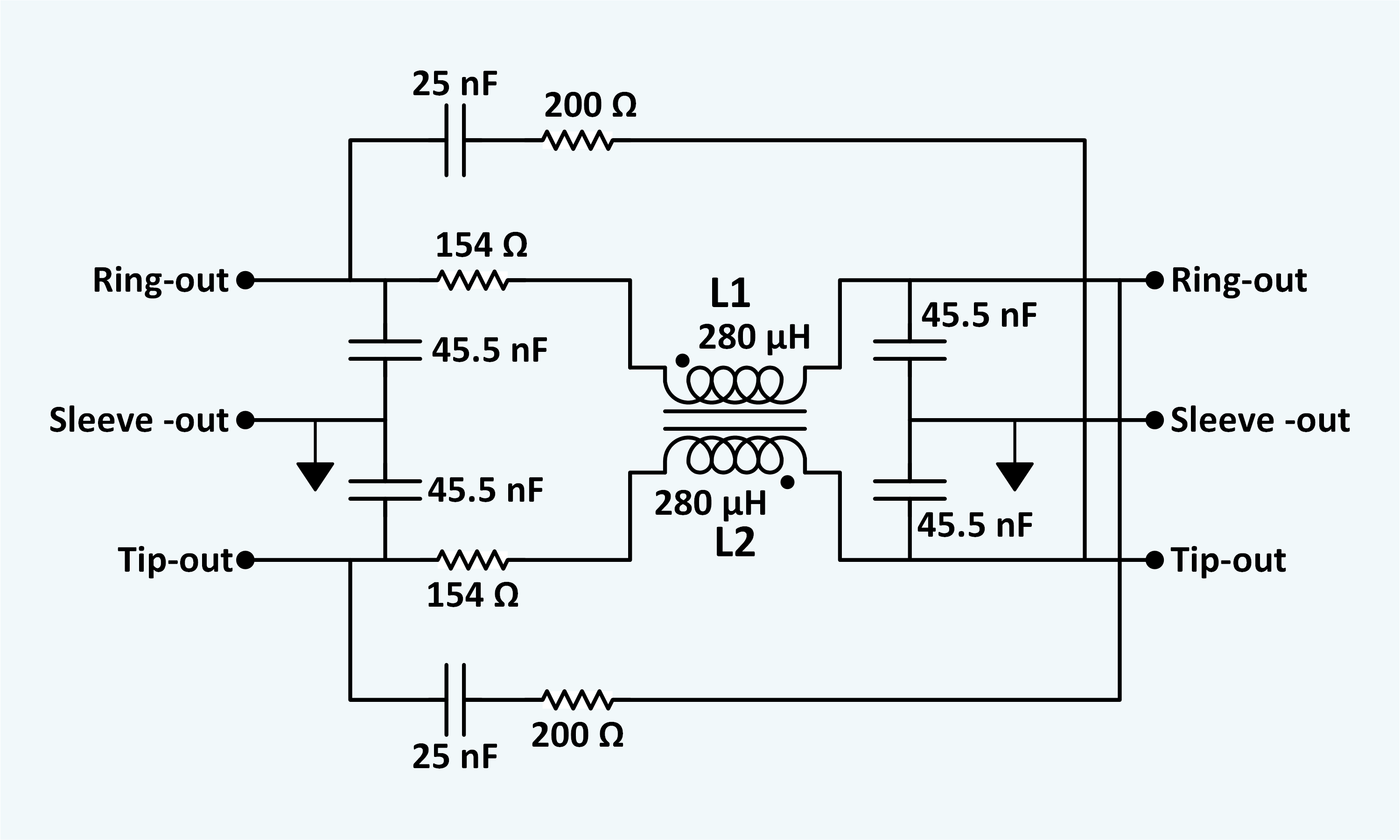|
Analog Delay Line
An analog delay line is a network of electrical components connected in cascade, where each individual element creates a time difference between its input and output. It operates on analog signals whose amplitude varies continuously. In the case of a periodic signal, the time difference can be described in terms of a change in the phase of the signal. One example of an analog delay line is a bucket-brigade device. Other types of delay line include acoustic (usually ultrasonic), magnetostrictive, and surface acoustic wave devices. A series of resistor–capacitor circuits (RC circuits) can be cascaded to form a delay. A long transmission line can also provide a delay element. The delay time of an analog delay line may be only a few nanoseconds or several milliseconds, limited by the practical size of the physical medium used to delay the signal and the propagation speed of impulses in the medium. Analog delay lines are applied in many types of signal processing circuits ... [...More Info...] [...Related Items...] OR: [Wikipedia] [Google] [Baidu] |
Scanline
A scan line (also scanline) is one line, or row, in a raster scanning pattern, such as a line of video on a cathode ray tube (CRT) display of a television set or computer monitor. On CRT screens the horizontal scan lines are visually discernible, even when viewed from a distance, as alternating colored lines and black lines, especially when a progressive scan signal with below maximum vertical resolution is displayed. This is sometimes used today as a visual effect in computer graphics. The term is used, by analogy, for a single row of pixels in a raster graphics image. Scan lines are important in representations of image data, because many image file formats have special rules for data at the end of a scan line. For example, there may be a rule that each scan line starts on a particular boundary (such as a byte or word; see for example BMP file format). This means that even otherwise compatible raster data may need to be analyzed at the level of scan lines in order to convert b ... [...More Info...] [...Related Items...] OR: [Wikipedia] [Google] [Baidu] |
Laurens Hammond
Laurens Hammond (January 11, 1895 – July 1, 1973), was an American engineer and inventor. His inventions include the Hammond organ, the Hammond clock, and the world's first polyphonic musical synthesizer, the Novachord. Youth Laurens Hammond was born in Evanston, Illinois, on January 11, 1895 to William Andrew and Idea Louise Strong Hammond. Laurens showed his great technical prowess from an early age. His father, William, took his own life in January 1897, ostensibly due to failure of the First National Bank of Illinois, which he had founded. Upon her husband's death, Idea, who was an artist, relocated to France with Laurens to further her studies, and the family spent the next eleven years in France and Germany. Early inventions When the family returned to Evanston in 1909, Laurens, then 14, was fluent in French and German. While in Europe, he had already designed a system for automatic transmission for automobiles. At his mother's suggestion, he submitted his de ... [...More Info...] [...Related Items...] OR: [Wikipedia] [Google] [Baidu] |
Kerosene
Kerosene, paraffin, or lamp oil is a combustible hydrocarbon liquid which is derived from petroleum. It is widely used as a fuel in aviation as well as households. Its name derives from el, κηρός (''keros'') meaning " wax", and was registered as a trademark by Canadian geologist and inventor Abraham Gesner in 1854 before evolving into a generic trademark. It is sometimes spelled kerosine in scientific and industrial usage. The term kerosene is common in much of Argentina, Australia, Canada, India, New Zealand, Nigeria, and the United States, while the term paraffin (or a closely related variant) is used in Chile, eastern Africa, South Africa, Norway, and in the United Kingdom. The term lamp oil, or the equivalent in the local languages, is common in the majority of Asia and the Southeastern United States. Liquid paraffin (called mineral oil in the US) is a more viscous and highly refined product which is used as a laxative. Paraffin wax is a waxy solid extracted from ... [...More Info...] [...Related Items...] OR: [Wikipedia] [Google] [Baidu] |
Piezoelectric Transducer
Piezoelectricity (, ) is the electric charge that accumulates in certain solid materials—such as crystals, certain ceramics, and biological matter such as bone, DNA, and various proteins—in response to applied mechanical stress. The word ''piezoelectricity'' means electricity resulting from pressure and latent heat. It is derived from the Greek word ; ''piezein'', which means to squeeze or press, and ''ēlektron'', which means amber, an ancient source of electric charge. The piezoelectric effect results from the linear electromechanical interaction between the mechanical and electrical states in crystalline materials with no inversion symmetry. The piezoelectric effect is a reversible process: materials exhibiting the piezoelectric effect also exhibit the reverse piezoelectric effect, the internal generation of a mechanical strain resulting from an applied electrical field. For example, lead zirconate titanate crystals will generate measurable piezoelectricity when their ... [...More Info...] [...Related Items...] OR: [Wikipedia] [Google] [Baidu] |
Echo Suppression
Echo suppression and echo cancellation are methods used in telephony to improve voice quality by preventing echo from being created or removing it after it is already present. In addition to improving subjective audio quality, echo suppression increases the capacity achieved through silence suppression by preventing echo from traveling across a telecommunications network. Echo suppressors were developed in the 1950s in response to the first use of satellites for telecommunications. Echo suppression and cancellation methods are commonly called acoustic echo suppression (AES) and acoustic echo cancellation (AEC), and more rarely line echo cancellation (LEC). In some cases, these terms are more precise, as there are various types and causes of echo with unique characteristics, including acoustic echo (sounds from a loudspeaker being reflected and recorded by a microphone, which can vary substantially over time) and line echo (electrical impulses caused by, e.g., coupling between the ... [...More Info...] [...Related Items...] OR: [Wikipedia] [Google] [Baidu] |
Bell Telephone Laboratories
Nokia Bell Labs, originally named Bell Telephone Laboratories (1925–1984), then AT&T Bell Laboratories (1984–1996) and Bell Labs Innovations (1996–2007), is an American industrial Research and development, research and scientific development S.A. (corporation), company owned by multinational company Nokia. With headquarters located in Murray Hill, New Jersey, Murray Hill, New Jersey, the company operates several laboratories in the United States and around the world. Researchers working at Bell Laboratories are credited with the development of radio astronomy, the transistor, the laser, the photovoltaic cell, the charge-coupled device (CCD), information theory, the Unix operating system, and the programming languages B (programming language), B, C (programming language), C, C++, S (programming language), S, SNOBOL, AWK, AMPL, and others. Nine Nobel Prizes have been awarded for work completed at Bell Laboratories. Bell Labs had its origin in the complex corporate organizat ... [...More Info...] [...Related Items...] OR: [Wikipedia] [Google] [Baidu] |
Sperry Gyroscope Company
Sperry Corporation was a major American equipment and electronics company whose existence spanned more than seven decades of the 20th century. Sperry ceased to exist in 1986 following a prolonged hostile takeover bid engineered by Burroughs Corporation, which merged the combined operation under the new name Unisys. Some of Sperry's former divisions became part of Honeywell, Lockheed Martin, Raytheon Technologies, and Northrop Grumman. The company is best known as the developer of the artificial horizon and a wide variety of other gyroscope-based aviation instruments like autopilots, bombsights, analog ballistics computers and gyro gunsights. In the post-WWII era the company branched out into electronics, both aviation related, and later, computers. History Early history The company was founded in 1910 by Elmer Ambrose Sperry, as the Sperry Gyroscope Company, to manufacture navigation equipment—chiefly his own inventions the marine gyrostabilizer and the gyrocompass� ... [...More Info...] [...Related Items...] OR: [Wikipedia] [Google] [Baidu] |
Artificial Transmission Line
In telecommunication, an artificial transmission line is a two-port electrical network that has the characteristic impedance, transmission time delay, phase shift, or other parameter(s) of a real transmission line. It can be used to simulate a real transmission line in one or more of these respects. Early artificial lines were used in telephony research and took the form of a cascade of lattice phase equalisers to provide the necessary delay. The lattice phase circuit was invented by Otto Zobel Otto Julius Zobel (October 20, 1887 – January 1970) was an electrical engineer who worked for the American Telephone & Telegraph Company (AT&T) in the early part of the 20th century. Zobel's work on filter design was revolutionary and led ... in the 1920s.Zobel, O J"Theory and design of uniform and composite electric wave filters" ''Bell System Technical Journal'', vol. 2 (1923), pp. 1–46. References {{reflist Telecommunications equipment ... [...More Info...] [...Related Items...] OR: [Wikipedia] [Google] [Baidu] |
Ladder Topology
Electronic filter topology defines electronic filter circuits without taking note of the values of the components used but only the manner in which those components are connected. Filter design characterises filter circuits primarily by their transfer function rather than their topology. Transfer functions may be linear or nonlinear. Common types of linear filter transfer function are; high-pass, low-pass, bandpass, band-reject or notch and all-pass. Once the transfer function for a filter is chosen, the particular topology to implement such a prototype filter can be selected so that, for example, one might choose to design a Butterworth filter using the Sallen–Key topology. Filter topologies may be divided into passive and active types. Passive topologies are composed exclusively of passive components: resistors, capacitors, and inductors. Active topologies also include active components (such as transistors, op amps, and other integrated circuits) that require powe ... [...More Info...] [...Related Items...] OR: [Wikipedia] [Google] [Baidu] |
Capacitor
A capacitor is a device that stores electrical energy in an electric field by virtue of accumulating electric charges on two close surfaces insulated from each other. It is a passive electronic component with two terminals. The effect of a capacitor is known as capacitance. While some capacitance exists between any two electrical conductors in proximity in a circuit, a capacitor is a component designed to add capacitance to a circuit. The capacitor was originally known as the condenser, a term still encountered in a few compound names, such as the '' condenser microphone''. The physical form and construction of practical capacitors vary widely and many types of capacitor are in common use. Most capacitors contain at least two electrical conductors often in the form of metallic plates or surfaces separated by a dielectric medium. A conductor may be a foil, thin film, sintered bead of metal, or an electrolyte. The nonconducting dielectric acts to increase the capacitor's ... [...More Info...] [...Related Items...] OR: [Wikipedia] [Google] [Baidu] |
Inductor
An inductor, also called a coil, choke, or reactor, is a passive two-terminal electrical component that stores energy in a magnetic field when electric current flows through it. An inductor typically consists of an insulated wire wound into a coil. When the current flowing through the coil changes, the time-varying magnetic field induces an electromotive force (''emf'') (voltage) in the conductor, described by Faraday's law of induction. According to Lenz's law, the induced voltage has a polarity (direction) which opposes the change in current that created it. As a result, inductors oppose any changes in current through them. An inductor is characterized by its inductance, which is the ratio of the voltage to the rate of change of current. In the International System of Units (SI), the unit of inductance is the henry (H) named for 19th century American scientist Joseph Henry. In the measurement of magnetic circuits, it is equivalent to . Inductors have values that typical ... [...More Info...] [...Related Items...] OR: [Wikipedia] [Google] [Baidu] |







.jpg)